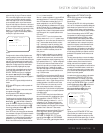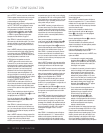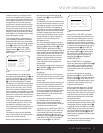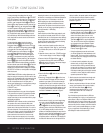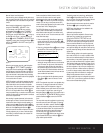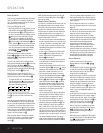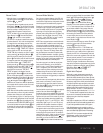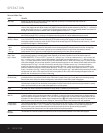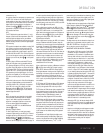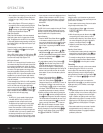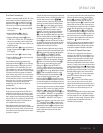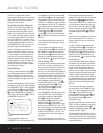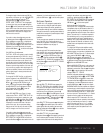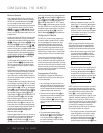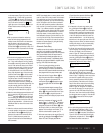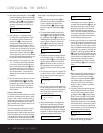
OPERATION 27
OPERATION
An optional, external RF demodulator is required to use
the DPR 1001 to listen to the Dolby Digital sound-
tracks available on laser discs. Connect the RF output of
the LD player to the demodulator and then connect the
digital output of the demodulator to the
Optical or
Coaxial Inputs k ÔÒ of the DPR 1001. No
demodulator is required for use with DVD players or
DTS-encoded laser discs.
DTS
The DTS digital audio system also delivers 5.1 or 6.1
discrete or matrix sound field reproduction. Both DTS
and Dolby Digital are digital, but they use different
methods of encoding the signals, and thus they require
different decoding circuits to convert the digital signals
back to analog.
DTS-encoded soundtracks are available on select DVD
and LD discs, as well as on special audio-only DTS
discs and video games. You may use any DVD, LD or
CD player equipped with a digital output to play DTS-
encoded discs with the DPR 1001. All that is required
is to connect the player’s output to either the
Optical or
Coaxial Input on the rear panel k or front panel
ÔÒ.
In order to listen to DVDs encoded with DTS sound
tracks, the DVD player must be compatible with the
DTS signal as indicated by a DTS logo on the player’s
front panel. Early DVD players may not be able to play
DTS-encoded DVDs. This does not indicate a problem
with the DPR 1001, as some players cannot pass the
DTS signal through to the digital outputs. If you are in
doubt as to the capability of your DVD player to handle
DTS discs, consult the player’s owner’s manual.
PCM
PCM, which is the acronym for Pulse Code Modulation,
is the type of digital bitstream used by standard CD
audio discs. When a CD or DVD player is connected
to the DPR 1001 and a CD is playing, the
PCM
Bitstream Indicator
A will light. You will also see
this indication if you are playing an LD disc with the
standard digital soundtrack.
MP3
MP3 is the popularly used description for the digital
audio format that is technically known as “MPEG-1/
Layer 3” audio.When a properly formatted MP3
signal from a compatible computer or sound card,
or from an external digital format translator, is
connected to the DPR 1001, the
MP3 Bitstream
Indicator
A will light.
Selecting a Digital Source
To utilize a digital mode, you must have properly
connected a digital source to the DPR 1001. Connect
the digital outputs from DVD players, HDTV receivers,
satellite systems or CD players to the
Optical or
Coaxial Inputs k ÔÒ, and configure the input
source for use with a digital input as shown on page 18.
In order to provide a backup signal and a source for
analog recording, the analog outputs on digital source
equipment should also be connected to their appropri-
ate inputs on the DPR 1001 rear panel (e.g., connect
the analog stereo audio output from a DVD to the
DVD
Audio Inputs
a on the rear panel).
When a digital source is playing, the DPR 1001 will
automatically detect whether it is a multichannel Dolby
Digital, DTS or MP3 source, or a conventional PCM
signal, which is the standard output from CD players. A
Bitstream Indicator A will light to confirm that the
digital signal is Dolby Digital, DTS, PCM or MP3.
Digital Status Indicators
When a digital source is playing, the DPR 1001 senses
the type of bitstream data that is present. Using this
information, the correct surround mode will automatically
be selected. For example, DTS bitstreams will cause the
unit to switch to DTS decoding, and Dolby Digital bit-
streams will enable Dolby Digital decoding. When the
unit senses PCM data from CDs or LDs, it will allow the
appropriate surround sources to be selected manually.
Since the range of available surround modes is dep-
endent on the type of digital data that is present, the
DPR 1001 uses a variety of indicators to let you know
what type of signal is present. This will help you to
understand the choice of modes.
When a digital source is playing, a
Bitstream Indicator
A will light to show which type of signal is playing:
DOLBY D: When the DOLBY D indicator lights, a
Dolby Digital bitstream is being received. Depending on
the settings on the source player and specific surround
information and number of channels on the disc, a
number of surround modes are possible. For discs with
full 5.1 audio, only the Dolby Digital and VMAx modes
are available.
DTS: When the DTS indicator lights, a DTS bitstream
is being received. When the unit senses this type of
data, only the applicable DTS mode may be used.
PCM: When the PCM indicator lights, a standard Pulse
Code Modulation signal is being received. This type of
digital audio is used by compact disc and laser disc
recordings. When a PCM bitstream is present, all
modes except Dolby Digital and DTS are available.
MP3: When the MP3 indicator lights, a compatible
MPEG 1/Layer 3 digital signal is being received. This is
the popular audio format used by many computer pro-
grams for recording compressed audio files. When an
MP3 bitstream is present, the sound will automatically
be played in the Stereo (Surround Off) mode. The sur-
round modes are not available during MP3 playback.
Night Mode
A special feature of Dolby Digital is the Night mode,
which enables specially encoded Dolby Digital input
sources to be played back with full digital intelligibility
while reducing the peak level by
1
/4 to
1
/3. This
prevents abruptly loud transitions from disturbing others,
without reducing the impact of the digital source. The
Night mode is available only when Dolby Digital signals
with special data are being played.
The Night mode may be engaged when a Dolby Digital
DVD is playing by pressing the
Night Mode Button
T on the remote. Next, press the
⁄
/
¤
Navigation
Buttons
n to select either the middle range or full
compression versions of the Night mode. To turn the
Night mode off, press the
⁄
/
¤
Navigation Buttons
n until the message in the lower third of the video
display and the
Main Infor-mation Display ^ reads
D-RANGE OFF.
The Night mode may also be selected to always be on
at either level of compression using the options in the
DOLBY SURR menu. See page 19 for informa-
tion on using the menus to set this option.
IMPORTANT NOTES ON DIGITAL PLAYBACK:
• While almost all DVD discs contain a Dolby Digital
soundtrack, the type of soundtrack (e.g., a full 5.1
presentation or only a stereo 2.0 soundtrack) avail-
able may differ from disc to disc. While many discs
instruct the player to default to the 5.1 output when
available, many players do not. Also, while many discs
now contain DTS soundtracks, in addition to the
Dolby Digital presentation, your player may
not auto-
matically output the DTS signal. Please check the
default settings in your DVD player so that it defaults
to the 5.1 output or DTS, when available, depending
on your listening preferences. Although the DPR 1001
is capable of decoding Dolby Digital 5.1, Surround EX
,
DTS and DTS-ES data streams, you may not be able
to access them unless your DVD player is properly
configured. Consult the owner’s manual for your DVD
player for more information on the proper menu set-
tings and disc-play commands so that the player
sends the correct digital information to the DPR 1001.
• When the digital playback source is stopped, or in a
pause, fast forward or chapter search mode, the digital
audio data will momentarily stop.This is normal and
does not indicate a problem with either the DPR 1001
or the source machine.The DPR 1001 will return to
digital playback as soon as the data is available and
when the machine is in a standard play mode.
• Although the DPR 1001 will decode virtually all DVD
movies, CDs and HDTV sources, it is possible that some
future digital sources may not be compatible with the
DPR 1001.
• Note that not all digitally encoded programs contain
full 5.1-channel audio. Consult the program guide
that accompanies the DVD or laser disc to determine
which type of audio has been recorded on the disc.
The DPR 1001 will automatically sense the type of
digital surround encoding used and adjust to
accommodate it.
31
31
31
(Continued from p. 25)



